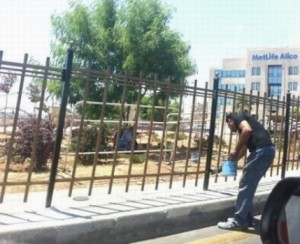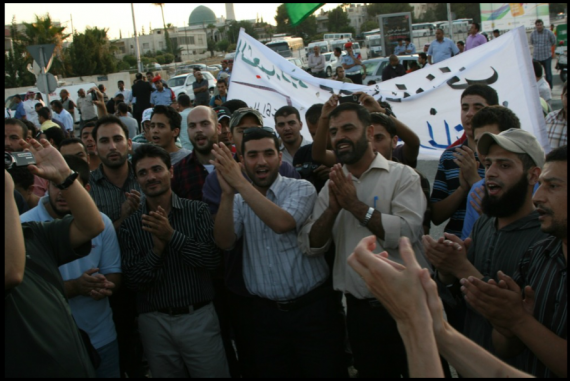By Sandra Hiari*
The fencing of one of Amman’s major roundabouts, the 4th circle, over the course of several hours marks an anti-urban attitude that the city – via its security apparatus, has indulged in. The move, which came in the aftermath of an open sit-in that a group of orphans and individuals born out of wedlock had organized, speaks to a reconfigured relationship between the city’s spaces and its citizens. It’s a story of a neglected population that was silenced through urban design.
Looming over 4th Circle, the Prime Ministry has proven that it keeps a watchful eye over the roundabout and that its tolerance of all those who think of it as a public space has begun to wane.
By fencing the roundabout, it resorted to a mentality of deprivation. The false notion of “public” has been overruled by a preference to civic non-representation. By closing down such a space, it narrows down its chances to allow citizens to voice their aspirations and grievances. It comes in total thematic consistency with the new elections law: selective misrepresentation.
Amman is a city with scant public space. If public spaces are to be social vestibules wherein citizens meet, greet or solely acknowledge each others’ presence, then closing down these spaces means a lower social pulse. Thecontrol of the 4th circle is problematic; it speaks to the whims of one interest group with a security mindset. Armed with a heap of iron painted in black and gold, it ignores all other interest groups as if they have no collective right to the roundabout**.
 The 4th circle was a circular concrete mass operating all fine and dandy as a transportation element up until the rules of the game began to change. Enter protests. Enter Police. Enter Gendarme. The act of fencing this space recalls the fencing and planting introduced to the Interior Ministry roundabout – center of the March 24/25 protest. One can’t help but compare this with Bahrain’s attitude to Pearl Roundabout. While Bahrain demolished the roundabout (it took demolition literally), Jordan resorted to a more pacified response: planting roses and using adorned fences. Both are two faces to a coin that seeks to restrict the citizenry’s access to the city. One could strongly argue that the city is not owned by the state, yet ironically, the state acts as if it owns the city. If one is to examine ownership of the Jordanian city through land ownership as an example, one would find that hundreds of thousands of individuals own the plots of land their houses rest on. If the area of these individual properties is added-up and compared to what authorities own (ex. the municipality) then the state doesn’t really “own” the city in the large sense.
The 4th circle was a circular concrete mass operating all fine and dandy as a transportation element up until the rules of the game began to change. Enter protests. Enter Police. Enter Gendarme. The act of fencing this space recalls the fencing and planting introduced to the Interior Ministry roundabout – center of the March 24/25 protest. One can’t help but compare this with Bahrain’s attitude to Pearl Roundabout. While Bahrain demolished the roundabout (it took demolition literally), Jordan resorted to a more pacified response: planting roses and using adorned fences. Both are two faces to a coin that seeks to restrict the citizenry’s access to the city. One could strongly argue that the city is not owned by the state, yet ironically, the state acts as if it owns the city. If one is to examine ownership of the Jordanian city through land ownership as an example, one would find that hundreds of thousands of individuals own the plots of land their houses rest on. If the area of these individual properties is added-up and compared to what authorities own (ex. the municipality) then the state doesn’t really “own” the city in the large sense.
The history of how Zahran Street (the artery that houses 4th Circle) evolved renders its newly-created symbolism sarcastic. Over the past decades, the artery had witnessed an increasing volume of traffic. In order to retain a seamless car flow, a sequence of tunnels were created underneath the roundabouts. All traffic signs were removed. The idea was that you don’t stop citizens, you help them move on.
*An urban planner working for the Government of Jordan.
**A Jordanian variation on Lefebvre’s slogan: Right to the City.
